Air Marshal (R) Inam H. Khan
Pakistan was the first Muslim country to recognize China in 1950 and the third non communist state. Pakistan then voted for a bill concerning the restoration of China’s legitimate rights in the UN. PIA became the first non-communist airline to fly into China in 1964.
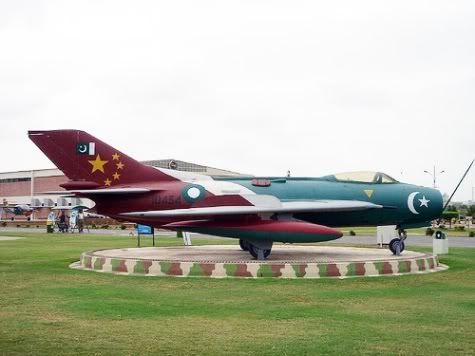
All Eggs in One Basket: The real transformation came when USA cut off all spares and other support such as training courses etc. both to India and Pakistan on breakout of 1965 Indo-Pak War. It did not hurt India much as they were mostly dependent on USSR. It had a few US transport twin piston-engine C-118 Packets with a third jet engine specially positioned on top of fuselage. It was specially designed for operations from high altitude airfields such as Leh, after Indo-China War of 1962. (As a POW we flew in one from Calcutta to Nagpur on way to our camp at Jabbalpur. Aircraft was in a rickety dilapidated shape due to poor maintenance).
This sudden cutting off of support effected Pakistan very adversely. PAF was very significantly effected as it had all her eggs in one (US) basket. After partition, PAF had acquired first 60 Sea Fury fighters in 1950, then followed by 12 jet Attackers from UK. In addition, for transportation, PAF replaced 8 odd C-47 Dakotas with 110( yes 110! ) British Bristol Freighters. We needed at the most 12 transport aircraft, but our RAF CinC bought 110 of them. We got a raw deal from Britishers in Attacker and Freighter sales inter alia many others – thanks to RAF C-in-C and other senior seconded RAF officers. Pakistan could only afford these small numbers with its own honest money. After joining CENTO and SEATO, PAF went whole hog for better US aircraft, acquiring 100 F-86s, 12 F-104s, approx 10 B-57s, 12 or so C-130s, and number of search and rescue helicopters and amphibians.
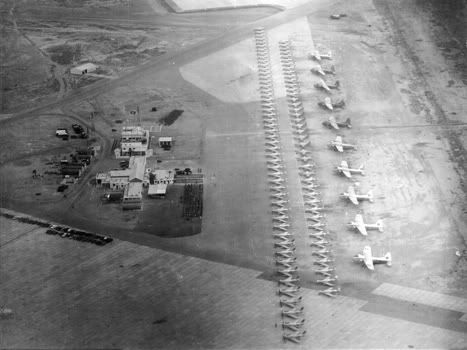

The two photos above show most of the newly acquired US planes at Muripur Airforce Base, Karachi in the 1950s. I was there with my newly raised 16 Squadron ( Motto as suggested by late Group Captain Mahmood (Edu) ‘tendrust-o-tenumend-o-drusht-zee’.
As you would observe, the birds are clean without drops. Nur Khan led the fly-past of ninety six clean F86s, taking off from old short 040 runway, climbing to 35,000 feet. From there diving and streaking over Karachi city at high speed to 1,500 feet high. Luckily no bird hit the planes even though the area was infested with them. Some pilots had very few hours on F86s; No 16 Squadron had then Pilot Officers late Akhtar (Air Commodore, Comdt Staff College) and P/O Riaz (Heli pilot later) who had only 5 hours or so on the type.
Ninety-six aircrafts lined up for take off on short 04, at 98% power crammed up together was not a joke. Recovery was even more remarkable as the runway was not only short but it had at the end a 2 feet high lip of main runway 27 under construction.
US Embargo Dilemma: Faced with this dilemma due to US embargo, PAF frantically looked around for replacements, but nothing was available soon and within our means. Though most of our top brass including President Ayub Khan, under the influence and over-awed by the West, had to eat the crow and beg China to help. For example, Chinese PM Chou En Lai, with his far sightedness first offered the construction of Karakoram Highway in1962. Pakistan turned it down lest USA got annoyed. Air Marshal Asghar Khan was sent to Peking during the War for immediate procurement of the aircraft and for the Chinese double barreled, very effective, 12.5 mm Ack Ack guns. Chinese PM graciously and promptly agreed to meet our request with the proviso that FM Ayub Khan will have to personally make the request. This he did soon after the war towards end of September. He visited Peking meekishly and very secretly lest USA got peeved. On advice from our Foreign Office, dominated by Brown Sahibs, Air Marshal Asghar suggested to Chou En Lai that these aircraft may be crated and secretly shipped to Jakarta, and from there to Karachi. Thus giving the impression to West that, just like Indonesian Submarines, these aircraft too have been obtained from there. It was an immature, time consuming and childish proposal.

The photo above shows PM Chou En Lai having exclusive lunch with our Ambassador M Sultan Khan and his wife Abida in the Embassy (Embassy is where Ambassadors live, Chancery is their office which is mistakenly called Embassy ). Occasion being the visit of M Shahabuddin, brother of first Pakistani PM Nazimuddin,( ex Chief Minister of combined Bengal pre-partition. He was a very honest but simple man who left little assets. His wife was living in a small house in some remote Karachi Colony till 1980 when Gen Zia allotted her some decent house.) Shahabuddin then was probably Speaker of Parliament.
Chou En Lai immediately shot the idea down and said that these will be made available at airbase like Hotian. It will be very easy to ferry them across to Pakistan from there. During this meeting Chinese PM enquired from AM as to how long it will take PAF pilots to achieve the necessary proficiency. Asghar Khan replied that our pilots are experienced aviators; they would not take more than 10 to 15 days. Remarkably PM disagreed and said that unlike your planes, these are equipped with metric systems, have configurations different from Western aircraft, and most of all there would be language problems. He thus opined it would require 6 to 8 weeks for transition. And it took that much. To highlight this, it took our pilots nearly one week to understand that switches on panels on right side of cockpit are in fact ‘circuit breakers’ and not switches as these appeared to be. China provided initially sixty F-6 aircraft along with tanks, arms and ordinance for 3 Army Divisons, large number of AA guns and ammunition etc..

And it was done almost free of cost and within days. One point always bothered the Chinese. China following policy of conservation, objected to our scales of ammunition. They said we follow American pattern of firing to frighten where as we should fire to kill. This reminds me, once in 1962 at PAF Naltar attending Ski Course, we 5 or 6 Wing Commanders went for Chakor shikar. We fired about two dozen cartridges but could not kill a single bird. Next day one local bearer took 4 cartridges, in the evening he brought 3 chakors and returned one unused cartridge. When we inquired, he said they approach bird behind a colorful shield and fired only after reaching it close,
First batch of PAF pilots reached China in early Oct 1965, where they were stationed sixty miles south of Tientsin Harbour. Base facilities were spartan but clean. Accommodation and food was prepared under Muslim requirements. They flew about 10 to 15 missions each on F-6, Chinese built Mig-19 aircraft. As stated earlier, China then made all efforts to conserve F-6s. They were thus fully covered and protected from sun and dust. They were taken close to beginning of runway; covers were removed at the last moment and mission accomplished from thereon. Protective measures were undertaken immediately after landing. Not a single fault occurred during training of the two batches of six pilots each, except one malfunctioning of a gauge. This was remarkable achievement. Life style was simple. The airfield was about a mile away from the residential area. When one of our pilots had hairline crack of ankle, he was provided with a cycle, otherwise every one walked.
Air Marshal Nur Khan’s Visit: C-in-C PAF Air Marshal Nur Khan paid two visits to China during my tenure as Air Attache at Peking. The first one was in Nov 1965 and second in Dec 1967.
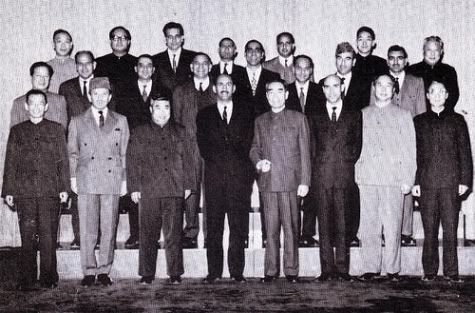
The above picture was taken during first visit, when he was accompanied by AVM Qadir, Air Cdre Z A Chaudhry, Air Cdre Khawaja Maintenance, my course mate Grp Capt S H Shah, Grp Capt Khawaja Supply and Group Capt Mustafa. Embassy is represented by Minister Durrani (in grey suit in front row) and First Secretary Yunus next to me behind Minister Durrani. Normally PM Chou En Lai did not meet Military Chiefs, but he had liking for Nur Khan and thus graciously had dinner with him followed by this photograph.
The visit was to review the progress of procurement of aircraft, tanks and other equipment. It also included a visit to the air base where our pilots were undergoing. Aircraft unserviceability was zero, Base workshop produced most of the spare parts themselves despite the fact that their workshops were not as well equipped as ours, according to Air Cdre Khawaja, ACAS Maintenance. They were remarkably self sufficient in every thing including food, vegetables, etc.
F-6 Aircraft: F-6 had good power weight ratio of 86%, giving it a lot of kick and maneuverability even at high altitude. But it was not a perfect aircraft. A serious problem faced in these aircraft was turbine buckets melting away or detaching and piercing through the other engine or pipes causing it afire. This was due to poor Russian metallurgy. Engines required change of the turbine buckets after every 100 hours. This was in contrast to an F104 engine requiring Inspection and Replacement if required (IRAN) after 1200 hours.
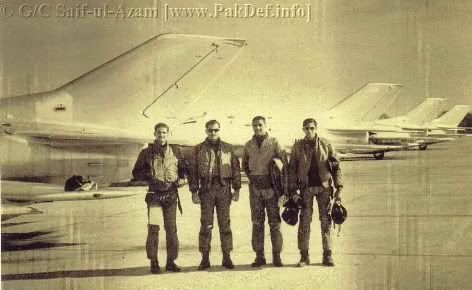
The photo above shows newly minted F-6s – just after their arrival in Pakistan
PAF installed British Martin Baker ejection seats amongst many other changes. Maintenance wise F-6 was a labor intensive aircraft when compared to US aircraft. Latter having modular systems which are expensive but efficient. F-6 was not pilot friendly aircraft in an emergency and cost us many lives.
On the whole, however, the F-6 was a great acquisition considering that these were provided promptly at a crucial juncture; when we were against the wall and not being able to fill the requirement from any other source. To top it off these were almost free of cost, thanks to the Chinese government and in particular PM Chou En Lai. They have thus earned our gratitude, goodwill and trust, despite our leader’s penchant for the West.
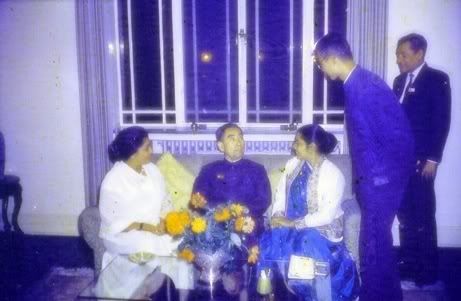
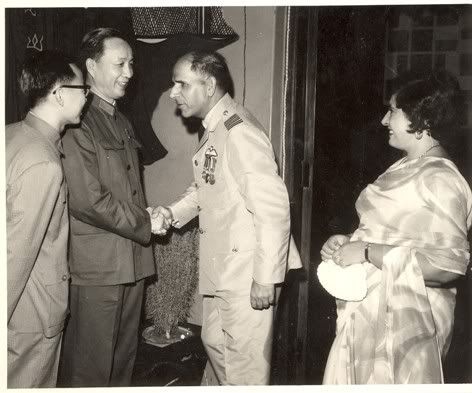
Multi Faceted Relationship: The efforts put in to developing an exemplary relationship by people of both countries in those days, has paid dividends across the board. We now have collaboration in both civil and defense industries. The Karakoram Highway and Gwadar Port are two mega projects that have the potential to transform the social landscape. While there are many lessons to derive from the experience, there are some that truly stand out.
Lessons To Learn: The first lesson is never to put all our key assets at the mercy of any one country. Despite our experience after 1965 we still tried to buy US F-16s and even paid for many of them, only to see their delivery embargoed and money not returned. In contrast the collaboration on JF-17 and other projects with the Chinese have borne fruit. Becoming self sufficient in essential items is a lesson to learn from the Chinese.
The other important lesson is to lead a simple life style and live within ones means. China when it became independent was in much worse shape than Pakistan. Chinese have shown that by living simply and focusing on important things, with correct priorities, they can achieve wonders. We can better protect our interests and sovereignty if we avoid dependence on aid and learn to stand on our feet. Is it too much to ask?
Air Marshal (R) Inam H. Khan was Pakistan’s first air attache to China. He was commissioned in 5th GD(P) Course in 1949 and has the unique honour of winning the coveted Sword of Honour, Best Pilot Trophy as well as the Ground Subjects Trophy. He later raised and commanded No 16 Squadron (F-86F), two fighter Wings (No 32 Fighter Ground Attack Wing and No 33 Fighter Ground Attack Wing). Served as the first Air Attache in Peking China after 1965 war. He commanded two Bases, viz PAF Base Peshawar and PAF Base Dacca. At the latter Base, he was also AOC East Pakistan during 1971. He was appointed as ACAS (Ops) after repatriation as a POW. His last appointment within PAF was as first Air Officer Commanding, Air Defence Command. Following that, in 1976 he was appointed as the first DG JS in the newly established JCSC Headquarters. In 1979 he was inducted in the Federal Cabinet, from where he resigned and retired from PAF in 1982. He is the recipient of the second highest military award, Hilal-e-Juraat. These reflections were written informally and first appeared at Planet Earth. ATP is grateful to the author for sharing these with our readership.



















































I would prefer if people didn’t turn this extraordinary blog into an necessary India Pakistan related bickering through some very sophisticated trolling that sometimes even admins can’t pick.
Yes the origins started with the F6s and then F-7Ps and A-5s gave some stability in the 80s and 90s. F-7PG or J-7E procured in the late 90s through 2004 is an extraordinary machine for its worth. JF-17 warrants a post by itself. Looking to the future, J-10 will go neck on neck with the falcon and is a testament to China’s strength in present day aviation. It is worth mentioning that JF-17 has a Mig 29’s RD-33 engine and J-10 – at least for the current production run – has SU-27’s engine. It used to be that there were falcons and then the distant second but capable birds. That gap will be eliminated very fast. The future will look something like this; J-10, F-16, JF-17, F-7PG and Mirage III/V but only those with Rose III upgrades. Those 60 free F6s have gone a long way in so many directions.
Learnt alot of interesting information from this blog which i didn’t know of earlier. Yes, it’s about time we stop depending on others and wait to be helped, we should learn to help our selves and protect the country’s lost self-esteem
I value writer’s portrayl of patriotism of his times. While we praise their sincere and much needed efforts in defence of our court in those days, we should not forget bigger picture that emerged from it. It should be noted China needed and utilized our energies to counter Indian threat (remember China & India had a war) and used its own energies to develop their country. China thus (may be inadvertantly) made our military grow faster to the point that it became the only force in political,economic and other aspects of Pakistan life.
I wish writer comment on this aspect, as well.
Imran thank you for the links. F6 will always have a special place in PAF history. In fact the F6 legacy continues to live on in A5s which are currently being replaced by JF-17s. I had never heard about the turbine bucket melting problem before this blog.. and I wonder if the problem was fixed in the A5s. Or one wonders if the A5 was as maintenance intensive as the F6 was?
Sajid: In the 1971, the US sided with India! Wow – I didn’t think anybody would make that claim. Is this a common feeling in Pakistan? Have you ever tried to independently look at facts to verify this?
One other thing I would like clarification on. I have seen many Pakistani commentators talking about the F16s that the US stopped delivery on due to the Pressler Amendment. The claim is made that the US took the money and never supplied the F16s. My understanding is that it wasn’t Pakistan’s money in the first place. The US had agreed to supply the F16s as part of its aid package it gave to the Pakistan government during the Afghan campaign. Therefore, any transfer of money from Pakistan to the US was entirely notional, as the money was that of the US taxpayer to begin with. Second, despite having no obligation under international law to do so, the US still transferred that money to Pakistan in the form of other goods. Hence, the aid was given to Pakistan exactly to the amount that the F16s would have cost.
Thus, if my understanding of events is correct, this entire practice of crying about US perfidy regarding the undelivered F16s is misplaced to be charitable, and much worse if one is not charitable. If there was any perfidy, it was on the part of the US president to the American people when he (Reagan throughout his term and Bush Sr. during the first couple of year) willfully lied every year to the US Congress about the status of Pakistan’s nuclear program. Other than that, when Bush Sr. conveyed to the US Congress about the true status of Pakistan’s nuclear program under the Pressler Amendment, he was merely doing his duty as required under the law and corrected gross misdemeanors committed by him and his predecessor for years (something for which he could be prosecuted, but never will be).